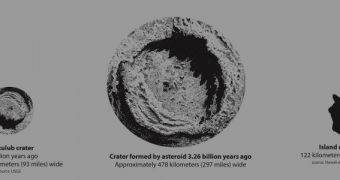A group of investigators from the Stanford University describe in a new study an ancient collision that they say occurred around 3.26 billion years ago. The impact, which was previously unknown, is now believed to have been so strong that it made the space rock which caused the Cretaceous-Paleogene extinction event seem like a pebble hitting a very big ocean.
The latter impact occurred 65.5 million years ago and is widely credited with having wiped out all dinosaurs from the face of the Earth, alongside numerous other land and marine species. In spite of this extreme level of global devastation, its effects simply cannot be compared to those produced by the far more ancient impacts, especially in terms of consequences.
Stanford researchers Norman Sleep and Donald Lowe reconstructed the history of the ancient asteroid impact and determined that it occurred around 3.26 billion years ago. In all likelihood, it was caused by an asteroid four to six times the diameter of the one that killed off the dinosaurs – between 37 and 58 kilometers (23 to 36 miles) across.
Upon impacting our planet, the space rock produced a crater around 500 kilometers (300 miles) across. The shock of the impact generated massive seismic waves, incomparable in intensity to anything we know today. If a magnitude scale existed at the time, these earthquakes would have topped it many times over.
Traces of the ancient impact were discovered in the Barterton greenstone belt, a region of South Africa. Both Stanford researchers analyzed the area in detail and concluded that the intensity of the asteroid impact that formed it is unrivaled in the past billion years. The team says that the space rock did not impact on Barterton directly, but in a more remote location, which has since been destroyed.
One possible implication of such a massive impact could be the transition between an earlier tectonic set of processes to the modern-day plate tectonic system that we can observe. It is possible that the entirety of our planet's crust felt the effects of the huge crash. At the time of the event, life was still relatively new to this world, having evolved around 3.8 billion years ago.
The new investigation provides “significant support for the idea that the impact may have been responsible for this major shift in tectonics,” comments researcher Frank Kyte, a geologist at the University of California in Los Angeles (UCLA), who was not a part of the new study.
Following the asteroid strike, the atmosphere most likely caught on fire, or at least became hot enough to boil the upper layers of the oceans. “We are trying to understand the forces that shaped our planet early in its evolution and the environments in which life evolved,” says Lowe, quoted by Space.
Details of the investigation were accepted for publication in an upcoming issue of the journal Geochemistry, Geophysics, Geosystems.

 14 DAY TRIAL //
14 DAY TRIAL //